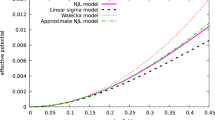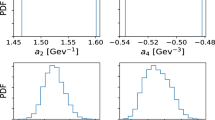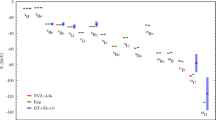Abstract
A relativistic Hartree–Fock Lagrangian including a chiral potential and nucleon polarisation is investigated in hopes of providing a better description of dense nuclear matter. We fully consider the contribution of the exchange Fock term to the energy and the self-energies, and in addition we investigate the nucleon’s compositeness and finite size effects (confinement and form factors) and short range correlations modeled by a Jastrow ansatz. These effects are added step by step, such that their impact on the dense matter properties can be analysed in details. The parameters of the model are adjusted to reproduce fundamental properties related to the QCD theory at low energy, such as the chiral symmetry breaking, nucleon’s quark substructure and Lattice-QCD predictions, as well as two empirical properties at saturation: the binding energy and the density. All other empirical parameters, e.g., symmetry energy and its slope, incompressibility modulus, effective mass, as well as spin–isospin Landau–Midgal parameter are predictions of the models and can be used to evaluate the gain of the different approximation schemes in describing nuclear properties. Bayesian statistics is employed in order to propagate parameter uncertainties into predictions for the nuclear matter properties. We show that the splitting of the effective Landau mass is largely influenced by the value of the \(\rho ^T\) coupling, and we show that the fit to the symmetry energy, which induces an increase of the coupling constant \(g_\rho \) by about 20–25% compared to the case where it is fixed by the quark model, provides a very good EoS compatible with the present nuclear physics knowledge.









Similar content being viewed by others
Data availability statement
This manuscript has no associated data or the data will not be deposited. [Authors’ comment: The data generated in this study is available upon request.]
References
H. Fritzsch, M. Gell-Mann, H. Leutwyler, Phys. Lett. B 47(4), 365 (1973)
T. Ablyazimov et al., Eur. Phys. J. A 53(3), 60 (2017). https://doi.org/10.1140/epja/i2017-12248-y
Y. Nambu, G. Jona-Lasinio, Phys. Rev. 124, 246 (1961). https://doi.org/10.1103/PhysRev.124.246
S. Weinberg, Phys. Lett. B 251, 288 (1990). https://doi.org/10.1016/0370-2693(90)90938-3
I. Tews, J. Carlson, S. Gandolfi, S. Reddy, Astrophys. J. 860(2), 149 (2018). https://doi.org/10.3847/1538-4357/aac267
J. Margueron, R. Hoffmann Casali, F. Gulminelli, Phys. Rev. C 97(2), 025805 (2018). https://doi.org/10.1103/PhysRevC.97.025805
K. Hebeler, J.M. Lattimer, C.J. Pethick, A. Schwenk, Astrophys. J. 773, 11 (2013). https://doi.org/10.1088/0004-637X/773/1/11
R. Somasundaram, I. Tews, J. Margueron, Phys. Rev. C 107, 025801 (2023). https://doi.org/10.1103/PhysRevC.107.025801
R. Somasundaram, J. Margueron, G. Chanfray, H. Hansen, Eur. Phys. J. A 58(5), 84 (2022). https://doi.org/10.1140/epja/s10050-022-00733-7
G. Chanfray, M. Ericson, P.A.M. Guichon, Phys. Rev. C 63, 055202 (2001). https://doi.org/10.1103/PhysRevC.63.055202
G. Chanfray, M. Ericson, Eur. Phys. J. A 25, 151 (2005). https://doi.org/10.1140/epja/i2005-10074-6
A. Bouyssy, J.F. Mathiot, N. Van Giai, S. Marcos, Phys. Rev. C 36, 380 (1987). https://doi.org/10.1103/PhysRevC.36.380
E. Oset, H. Toki, W. Weise, Phys. Rep. 83(4), 281 (1982). https://doi.org/10.1016/0370-1573(82)90123-5
M.C. Birse, Phys. Rev. C 53, R2048 (1996). https://doi.org/10.1103/PhysRevC.53.R2048
G. Chanfray, M. Ericson, Phys. Rev. C 83, 015204 (2011). https://doi.org/10.1103/PhysRevC.83.015204
G. Chanfray, D. Davesne, M. Ericson, M. Martini, Eur. Phys. J. A 27, 191 (2006). https://doi.org/10.1140/epja/i2005-10245-5
E. Massot, G. Chanfray, Phys. Rev. C 78, 015204 (2008). https://doi.org/10.1103/PhysRevC.78.015204
R.K. Bhaduri, Models of the Nucleon: From Quarks to Soliton (Addison-Wesley, Boston, 1988)
G. Höhler, E. Pietarinen, Nucl. Phys. B 95(2), 210 (1975). https://doi.org/10.1016/0550-3213(75)90042-5
P.A.M. Guichon, Phys. Lett. B 200, 235 (1988). https://doi.org/10.1016/0370-2693(88)90762-9
J. Hu, H. Toki, W. Wen, H. Shen, Eur. Phys. J. A 43(3), 323 (2010)
W.H. Long, N. Van Giai, J. Meng, Phys. Lett. B 640(4), 150 (2006). https://doi.org/10.1016/j.physletb.2006.07.064
W.H. Long, H. Sagawa, N. Van Giai, J. Meng, Phys. Rev. C 76, 034314 (2007). https://doi.org/10.1103/PhysRevC.76.034314
G. Chanfray, M. Ericson, Phys. Rev. C 75, 015206 (2007). https://doi.org/10.1103/PhysRevC.75.015206
G. Chanfray, H. Hansen, J. Margueron, (2023). https://doi.org/10.48550/arXiv.2304.01036
D.B. Leinweber, A.W. Thomas, R.D. Young, Phys. Rev. Lett. 92, 242002 (2004). https://doi.org/10.1103/PhysRevLett.92.242002
W. Armour, C. Allton, D. Leinweber, A. Thomas, R. Young, Nucl. Phys. A 840(1–4), 97 (2010). https://doi.org/10.1016/j.nuclphysa.2010.03.012
J. Margueron, F. Gulminelli, Phys. Rev. C 99 (2019). https://doi.org/10.1103/PhysRevC.99.025806
P. Guichon, H. Matevosyan, N. Sandulescu, A. Thomas, Nucl. Phys. A 772(1–2), 1 (2006). https://doi.org/10.1016/j.nuclphysa.2006.04.002
P. Bernardos, V.N. Fomenko, N.V. Giai, M.L. Quelle, S. Marcos, R. Niembro, L.N. Savushkin, Phys. Rev. C 48, 2665 (1993). https://doi.org/10.1103/PhysRevC.48.2665
J.R. Stone, P. Guichon, H. Matevosyan, A. Thomas, Nucl. Phys. A 792(3–4), 341 (2007). https://doi.org/10.1016/j.nuclphysa.2007.05.011
R. Machleidt, K. Holinde, C. Elster, Phys. Rep. 149(1), 1 (1987). https://doi.org/10.1016/S0370-1573(87)80002-9
S. Marcos, J.F. Mathiot, M. López-Quelle, R. Niembro, P. Bernardos, Nucl. Phys. A 600(4), 529 (1996). https://doi.org/10.1016/0375-9474(95)00507-2
J. Hu, H. Toki, H. Shen, J. Phys. G Nucl. Part. Phys. 38(8), 085105 (2011). https://doi.org/10.1088/0954-3899/38/8/085105
M. Ichimura, H. Sakai, T. Wakasa, Prog. Part. Nucl. Phys. 56(2), 446 (2006). https://doi.org/10.1016/j.ppnp.2005.09.001
F. Osterfeld, Rev. Mod. Phys. 64, 491 (1992). https://doi.org/10.1103/RevModPhys.64.491
T. Suzuki, H. Sakai, Phys. Lett. B 455(1), 25 (1999). https://doi.org/10.1016/S0370-2693(99)00445-1
J. Margueron, S. Goriely, M. Grasso, G. Colò, H. Sagawa, J. Phys. G: Nucl. Part. Phys. 36(12), 125103 (2009). https://doi.org/10.1088/0954-3899/36/12/125103
I.N. Borzov, S.V. Tolokonnikov, S.A. Fayans, Sov. J. Nucl. Phys. (Engl. Transl.) 40(5) (1984). https://www.osti.gov/biblio/5596979
I. Borzov, Nucl. Phys. A 777, 645 (2006). https://doi.org/10.1016/j.nuclphysa.2005.05.147
J. Dobaczewski, W. Nazarewicz, P.G. Reinhard, J. Phys. G Nucl. Part. Phys. 41(7), 074001 (2014). https://doi.org/10.1088/0954-3899/41/7/074001
M. Jaminon, C. Mahaux, Phys. Rev. C 40, 354 (1989). https://doi.org/10.1103/PhysRevC.40.354
Z. Ma, J. Rong, B.Q. Chen, Z.Y. Zhu, H.Q. Song, Phys. Lett. B 604, 170 (2004). https://doi.org/10.1016/j.physletb.2004.11.004
E.N.E. van Dalen, C. Fuchs, A. Faessler, Phys. Rev. C 72, 065803 (2005). https://doi.org/10.1103/PhysRevC.72.065803
C. Drischler, A. Carbone, K. Hebeler, A. Schwenk, Phys. Rev. C 94, 054307 (2016). https://doi.org/10.1103/PhysRevC.94.054307
A. Gezerlis, I. Tews, E. Epelbaum, S. Gandolfi, K. Hebeler, A. Nogga, A. Schwenk, Phys. Rev. Lett. 111, 032501 (2013). https://doi.org/10.1103/PhysRevLett.111.032501
C. García-Recio, J. Navarro, V.G. Nguyen, L. Salcedo, Ann. Phys. 214(2), 293 (1992). https://doi.org/10.1016/S0003-4916(05)80003-X
Acknowledgements
We would like to acknowledge Wenhui Long for sharing his RHF code in nuclear matter, from which the present models has been implemented. M.C., J.M., H.H. and G.C. are supported by the CNRS-IN2P3 MAC masterproject, and benefit from PHAROS COST Action MP16214. R.S. is supported by the U.S. Department of Energy, Office of Science, Office of Nuclear Physics, through the Los Alamos National Laboratory. Los Alamos National Laboratory is operated by Triad National Security, LLC, for the National Nuclear Security Administration of U.S. Department of Energy (Contract No. 89233218CNA000001). R.S. also receives support from the Laboratory Directed Research and Development program of Los Alamos National Laboratory under project number 20220541ECR. R.S. also acknowledges support from the Nuclear Physics from Multi-Messenger Mergers (NP3M) Focused Research Hub which is funded by the National Science Foundation under Grant Number 21-16686. This work is supported by the STRONG-2020 network from the European Union’s Horizon 2020 research and innovation program under grant agreement No. 824093 (H.H.); the LABEX Lyon Institute of Origins (ANR-10-LABX-0066) of the Université de Lyon for its financial support within the program Investissements d’Avenir (ANR-11-IDEX-0007) of the French government operated by the National Research Agency (ANR).
Author information
Authors and Affiliations
Corresponding author
Additional information
Communicated by Thomas Duguet.
Appendices
Appendix A: Explicit expressions for the direct contributions to the energy and to the self-energies
At the Hartree level, we have the direct terms contributions:
In what follows, we will write the exchange part of the self-energies.
Appendix B: Explicit expressions for the exchange self-energies in the case A (pure HF calculation)
1.1 Appendix B.1: \({ s\, \textrm{coupling}}\)
The rearrangement term \(\varSigma _S^{rg}\) gives momentum independent contributions to the scalar self energy, one due to the dependence of the effective coupling constant on the scalar field, i.e \(g^*_s(\bar{s})\) :
with \(\tilde{\kappa }_{NS}\) defined in Eq. (7), and the other contribution due to the dependence of the effective scalar mass \(m^*_s(\bar{s})\) on the scalar field :
where the derivative of the in-medium sigma mass with respect to the scalar density is :
1.2 Appendix B.2: \({\delta \, \textrm{coupling}}\)
1.3 Appendix B.3: \({\omega \, \textrm{coupling}}\)
1.4 Appendix B.4: \({\rho ^V\, \textrm{coupling}}\)
1.5 Appendix B.5: \({\rho ^{VT}\, \textrm{coupling}}\)
1.6 Appendix B.6: \({\rho ^{T}\, \textrm{coupling}}\)
1.7 Appendix B.7: \({\pi \, \textrm{coupling}}\)
After performing the angular integrations, we obtain the Eqs. (37) to (39).
Appendix C: Expressions for the exchange self-energies in the case D (HF with FF+SRC calculation)
1.1 Appendix C.1: \({\pi \, \textrm{coupling}}\)
1.2 Appendix C.2: \({\rho ^T\, \textrm{coupling}}\)
Appendix D: Derivation of the spin–isospin Landau–Migdal parameter \(g^\prime \)
We start from the non-relativistic reduction of the \(\rho \) potential, expressed in the center of mass reference frame (\({\textbf{p}}+{\textbf{p}}^\prime =0\)) as in Ref. [32], which provide the following contribution to the spin–isospin central interaction,
where we have employed coupling constants consistently with our Lagrangian (4). The spin–isospin central interaction has three components arising from the vector, vector-tensor and tensor part of the interaction. For the \(\pi \) interaction, we simply have
We can now define the Landau–Migdal parameter \(G'\) which governs the response in the Gamow–Teller (GT) channel and is defined as the spin–isospin channel of the central interaction,
The Landau–Migdal parameter \(G^\prime \) takes the contribution from the \(\rho \) and the \(\pi \) given in Eqs. (D.13) and (D.14), and evaluated at \(\textrm{q}=0\).
1.1 Appendix D.1: Model A
We have for the pure HF model (model A), from
The dimensionless Landau–Migdal interaction \(g_A^\prime (\textrm{q})\) is defined as,
with
with \(\mathcal {C}_\rho = \left( f_\pi g_\rho \kappa _\rho /(g_AM_N)\right) ^2\).
This expression reduces to the Landau–Migdal parameter at the long-wave length limit \(\textrm{q}\rightarrow 0\). Since \(V_{A,\alpha }(\textrm{q}\rightarrow 0)\rightarrow 0\), we obtain for the GT Landau–Migdal parameter \(g^\prime _A=0\) in the pure HF model (model A).
Note that in nuclear physics a different dimensionless parameter \({\tilde{G}}^\prime \) is defined as \({\tilde{G}}^\prime =N_0G^\prime \), where \(N_0\) is the density of state in symmetric matter and at saturation density \(N_0=2M_N^* k_F/\pi ^2\) (\(N_0\approx 38\times 10^{3}\) MeV\(^2\) for \(M_N^*\approx 0.7 M_N\)), such that \({\tilde{G}}^\prime =N_0(g_A/2f_\pi )^2g^\prime \approx 1.6g^\prime \). See Ref. [47] for more details.
For model A, we can see directly from Eqs. (D.13) and (D.14) that
1.2 Appendix D.2: Model B
For model B, we replace \(V_A(\textrm{q})\) by \(V_B(\textrm{q})\) as in Eq. (43) for the \(\rho ^T\) and \(\pi \) interaction, so
and for the dimensionless Landau–Migdal parameter,
1.3 Appendix D.3: Model C
For model C with FF, \(F_\alpha (\textrm{q}=0)=1\), so we simply get the same as in the case A, namely
1.4 Appendix D.4: Model D
Finally, for model D, we replace \(V_A(\textrm{q})\) by \(V_D(\textrm{q})\) as in Eq. (65) for the \(\rho ^T\) and \(\pi \) interaction, and \(V_C(\textrm{q})\) for the rest, thus we get
The dimensionless Landau–Migdal parameter reads,
Note that if we include the SRC in all interaction channels, we would have \(V_D(\textrm{q})\) appearing for all terms in Eq. (D.23) instead of \(V_C(\textrm{q})\), and the contribution from the \(\rho \) and \(\rho ^T\) would simply add together and we would have \(\kappa _\rho \longmapsto 1+\kappa _\rho \) appearing in \(C_\rho \) instead.
Rights and permissions
Springer Nature or its licensor (e.g. a society or other partner) holds exclusive rights to this article under a publishing agreement with the author(s) or other rightsholder(s); author self-archiving of the accepted manuscript version of this article is solely governed by the terms of such publishing agreement and applicable law.
About this article
Cite this article
Chamseddine, M., Margueron, J., Chanfray, G. et al. Relativistic Hartree–Fock chiral Lagrangians with confinement, nucleon finite size and short-range effects. Eur. Phys. J. A 59, 177 (2023). https://doi.org/10.1140/epja/s10050-023-01089-2
Received:
Accepted:
Published:
DOI: https://doi.org/10.1140/epja/s10050-023-01089-2




